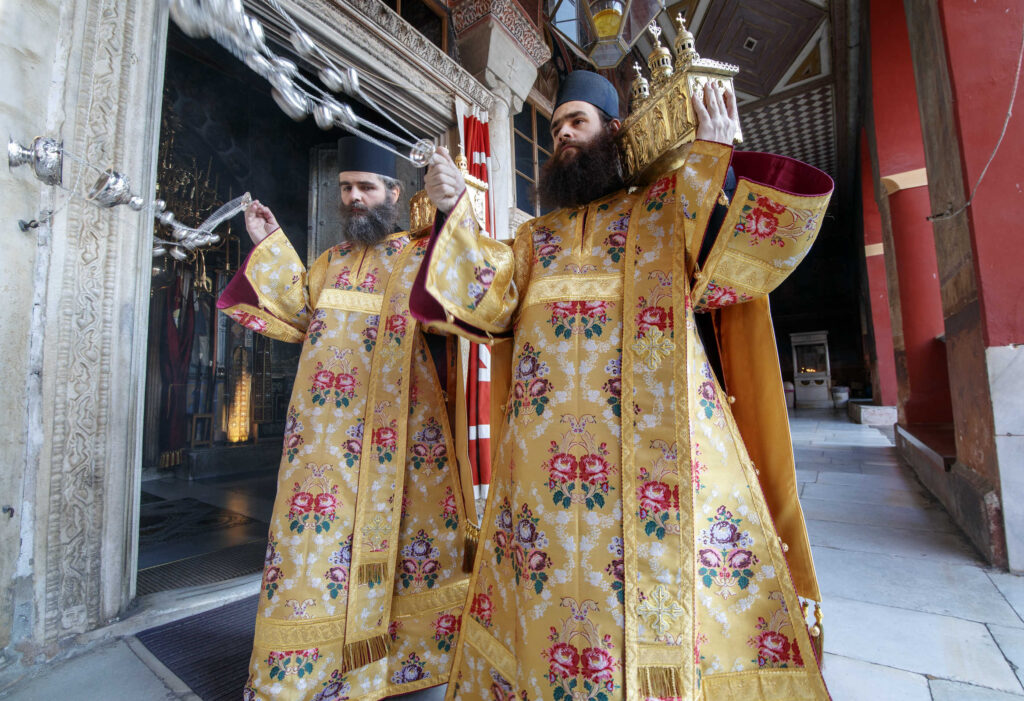The Orthodox Deacon is the third and lowest degree of the major orders of clergy in the Orthodox Church, following the Bishop (1st) and the Presbyter (2nd). The word deacon (in Greek διάκονος) means “servant,” “waiting-man,” “minister,” or even “messenger”: originally, it referred mostly to a person who waited on tables.
It is generally assumed that the office of deacon originated in the selection of seven men by the apostles, among them Saint Stephen, to assist with the charitable work of the early church as recorded in the Book of Acts, chapter 6.
The deaconess
The title deaconess (διακόνισσα diakónissa) is not found in the Bible. However, one woman, Phoebe, is mentioned at Romans 16:1–2 as a deacon (διάκονος diákonos) of the church in Cenchreae. Nothing more specific is said about her duties or authority, although it is assumed she carried Paul’s Letter to the Romans.
The vestments
The vestments of the deacon are the sticharion, the orarion, and the epimanikia.
All degrees of clergy wear the sticharion which is a long-sleeved tunic that reaches all the way to the ground. It reminds the wearer that the grace of the Holy Spirit covers him as with a garment of salvation and joy. For deacons, the sticharion has wide sleeves and is made of a heavier fabric than that of the priest and bishop, who wear their sticharia under other vestments.
The second part of a deacon’s vestments is the orarion. The orarion is a narrow band of material that the deacon wears wrapped around his body and draped over his left shoulder. It represents the grace of the Holy Spirit that, in ordination, anoints the deacon like oil. It is the principal vestment of the deacon and, without it, he cannot serve. When the deacon leads the people in prayers or invites them to attention, he holds one end of his orarion in his right hand and raises it. The priest’s epitrachelion and the bishop’s omophorion are specialized types of the orarion.
The final parts of a deacon’s vestments are the epimanikia. The epimanikia are cuffs that are worn around the wrists, tied by a long cord. These are also worn by the bishop and priest. They serve the practical purpose of keeping the inner garments out of the way during the services. They also remind the wearer that he serves not by his own strength but with the help of God.
Orthodox deacons at feasts
At the big feasts, deacons may have on their shoulders special kiboria—decorated boxes usually in the shape of a Church, which nowadays are empty but, in the past, they used to hold burning coals for the thurible. Because the kiboria were pretty hot, the deacons used to wear on their shoulders, under the kiboria, a thick cloth in order to protect their garments. Nowadays, these thick cloths are transformed to decorative veils symbolizing the grace of the Holy Spirit which cover them.
Also, at feasts, the deacons have cherubims—metal decorations of rounded shape symbolizing the angels which are present at the Liturgy. Also, if a bishop is present, they hold for him the dikirion (Greek: δικήριον or δίκηρον) and trikirion (τρικήριον or τρίκηρον) which are liturgical candlesticks. The words mean “dual candle” and “triple candle,” respectively, because the dikirion holds two candles, representing the dual nature of Jesus, and the trikirion holds three, representing the three persons of the Holy Trinity. The candleholders are mounted at an angle so that the candles cross each other.
Deacons are permitted to wear a cassock; this is done as a sign of his suppression of his own tastes, will, and desires, and his canonical obedience to God, his bishop, and the liturgical and canonical norms of the Church. Deacons are also permitted to wear the exoraso (or ryassa).
During services, the deacon is usually vested in a sticharion with an orarion that hangs over the left shoulder; with the exception of around the consecration of Communion, when the deacon will, for practicality, arrange his sticharion like a subdeacon.
Rights
In addition, to complete his duties, the orthodox deacon is permitted to touch the Table of Oblation, the Altar, and to move through the Royal Doors.
Read the captions of these images for more explanations
— Source: asceticexperience.com
